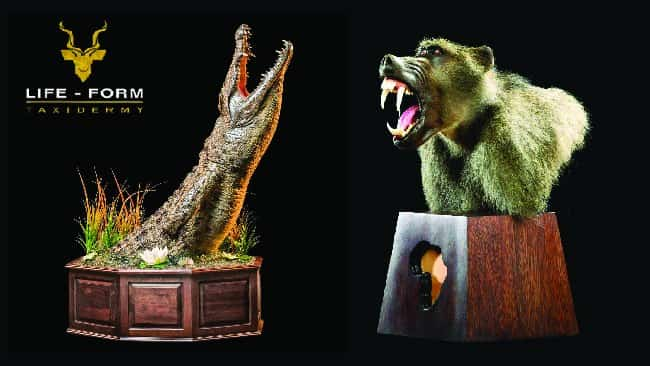As a form of decorative art, trophy, or museum exhibit, taxidermy is the practice of preparing and mounting animal skins for viewing. Even the name taxidermy itself has Greek origins; it was originally a term for arranging skin for display.
Skills in sculpture, painting, and tanning are commonly connected with it. The professionals that carry out this age-old trade are known as “Taxidermists”. Taxidermists can find work in a wide number of fields.
For hunters, the chance to experience the wildlife and sceneries of Southern Africa is truly once in a lifetime. For many hunters, it takes time, skill and patience to shoot a trophy, so that you will likely want to preserve your precious trophy for years to come. This is where taxidermy comes in.
If you want taxidermy but would rather display it on the floor than the walls, a pedestal mount is a great option.
You and your taxidermist can get as creative as you like with the classic pedestal mount. No longer are you limited to a single zebra or sable on a plinth; now you may create sophisticated multi-tiered animal structures.
The aesthetics of taxidermy floor standing pedestal mounts
Floor standing pedestal mounts are typically shoulder or cape mounts, with extra skin left over at the back to conceal the mount’s back.
The wooden pedestal that the mount is attached to, can be a solid wooden pedestal or may be inlayed with trophy skin panels either taken from your trophy backskin or supplied. The African shaped skin inlay is becoming a fast favorite amongst avid hunters. Wooden pedestals may be painted a solid color, or even topped with realistic-looking ‘vegetation/habitat.’ Pewter inlays are also offered for wooden pedestals. Life-Form Taxidermy offers a variety of wooden pedestals for your choosing.
For example, a sable with horns that extend far back over the body is best displayed on a wooden pedestal. A giraffe shoulder/neck mount looks particularly striking when displayed on a floor standing, base or short wooden pedestal, with habitat and/or with the inclusion of a branch.
The structure of taxidermy pedestal mounts
You might think of a game pedestal mount as a mount that rests on a wooden pedestal. The manikin turns on a steel pipe concealed beneath its hardwood base, which is supported by a steel rod cast inside the body of the figure.
In the event that the cape is too short, the back of the mount can be closed with leather or black felt. The floor bases/pedestals of all medium – and large – sized wooden mounts feature castors, making it easy to move the entire unit around. This comes in handy when washing the floor or changing furniture in a safari themed space.
The aesthetics of taxidermy wall pedestal mounts
The difference between a shoulder mount and wall pedestal mount is noticeable to trained eye:
A shoulder mount displays the shoulders of a trophy facing forward with the back of the trophy flat so that it can secured onto the wall. You can either turn the head right or left or have it facing straight.
A wall pedestal mount features a graceful curve at the back, with either the left or right shoulder being secured to the wall and the opposite shoulder facing into the room.
If an animal is making a sharp right turn and appearing to be facing straight ahead (a 90-degree turn), it signifies that its left shoulder is against the wall and it is staring straight out from the wall.
If an animal is making a left turn while staring straight ahead, it has turned ninety degrees, so its right shoulder is against the wall and it is staring straight out from the wall.
If an animal is to face 115-degree turn it will determine from the 90-degree angle.
Table of Contents
